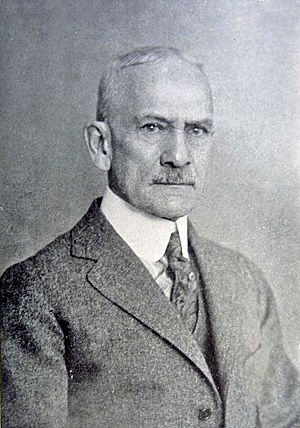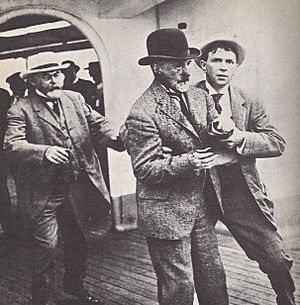Charles Chapin facts for kids
Charles E. Chapin (born October 19, 1858 – died December 13, 1930) was a famous newspaper editor in New York City. He worked for Joseph Pulitzer’s newspaper, The Evening World. Chapin was known for his strong opinions and how he managed the newsroom. He passed away in Sing Sing prison.
Contents
Chapin's Newspaper Career
Charles Chapin was born in Watertown, New York. He started working for a newspaper in Kansas when he was only 14 years old. Later, he moved to Chicago and worked for the Chicago Tribune. There, he became well-known as a reporter who covered crime stories.
In 1898, Chapin was hired by The Evening World in New York. This newspaper was run by the Pulitzer family. The Evening World focused on exciting news like crime and entertainment. It became one of the most popular newspapers in the country. This was partly because of Chapin's great sense for news and his use of big, eye-catching headlines.
Chapin was known as a very strict boss. People say he fired 108 journalists during his time as editor. One time, he even fired Joseph Pulitzer Jr., the son of the newspaper's owner! This happened because Joseph Jr. often missed work. But his father, Joseph Pulitzer Sr., supported Chapin's decision. He later sent his son to another newspaper, where Joseph Jr. helped make it very successful.
Chapin believed that gathering news in a big city was like a well-oiled machine. He thought the city editor should be in charge of everything. He called himself a "newspaper man," not a "journalist." He felt that real newspaper people knew how to find and write news, while "journalists" was a word used by less skilled people.
Chapin always pushed his reporters to find breaking news. He once told a reporter who had been hurt by a powerful person's security, "You go back and tell Morgan he can’t scare me!"
Famous Photograph
One of Chapin's biggest achievements was publishing a photograph from an Evening World photographer. This picture showed the exact moment when New York mayor William Jay Gaynor was shot by someone who tried to harm him. It was a very important and shocking photo for its time.
Chapin's Later Life and Death
Charles Chapin died from pneumonia on December 13, 1930. He passed away while he was in Sing Sing.
What People Thought of Chapin
For 20 years, Charles Chapin was the city editor of The Evening World. Many people in the newspaper business thought he was the best city editor ever. However, those who worked for him often did not like him.
A famous reporter named Irvin S. Cobb once heard that Chapin was sick. He supposedly said, "I hope it’s nothing trivial," meaning he hoped it was a serious illness. Another writer, Andy Logan, said Chapin had a "terrible temper." Many of his staff felt he didn't care about their feelings or problems.
Joseph Pulitzer, the owner of the newspaper, even had a secret code name for Chapin: "Pinch." Some people believed that Chapin's focus on exciting and sometimes exaggerated stories helped create a style of newspaper reporting that focused on sensationalism.



